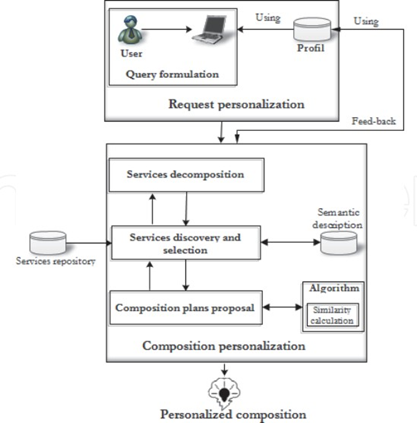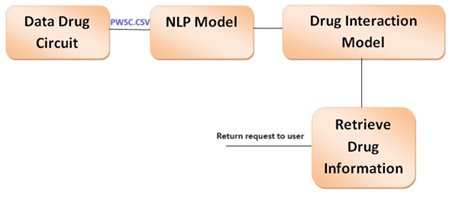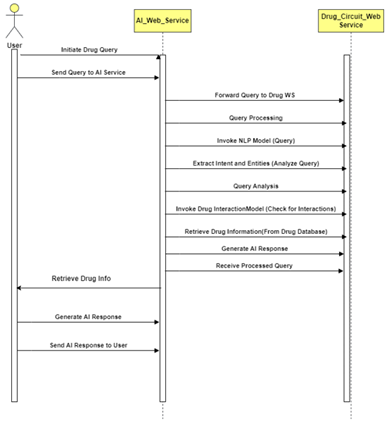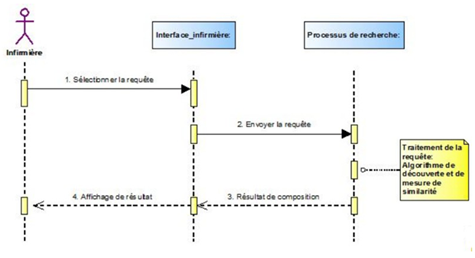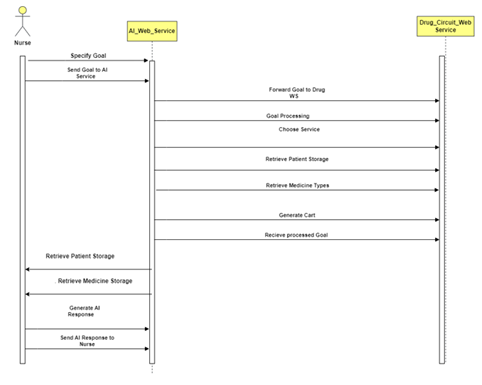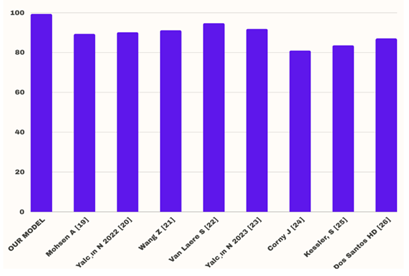Research Article
Personalized Web Services Composition Using Artificial Intelligence
1FSEG Sfax, University Sfax, Tunisia.
2RIADI Laboratory, University of Manouba, Tunisia.
3ENSI, University of la Manouba, Tunisia.
*Corresponding Author: Imen Chebbi, FSEG Sfax, University Sfax, Tunisia.
Citation: Chebbi I, Abidi S, Leila B. Ayed. (2024). Personalized Web Services Composition Using Artificial Intelligence. Scientific Research and Reports, BioRes Scientia Publishers. 1(3):1-11. DOI: 10.59657/2996-8550.brs.24.014
Copyright: © 2024 Imen Chebbi, this is an open-access article distributed under the terms of the Creative Commons Attribution License, which permits unrestricted use, distribution, and reproduction in any medium, provided the original author and source are credited.
Received: May 15, 2024 | Accepted: May 31, 2024 | Published: June 07, 2024
Abstract
The process of creating new services by integrating existing ones is known as service composition. It is regarded as one of the most difficult tasks in a distributed and dynamic setting. In general, the com- position process entails looking for existing services in a certain domain, selecting the suitable service, coordinating composition flow, and activating services. Researchers have been studying the need of web service com- position using artificial intelligence extensively over the last few years. As a result, numerous solutions and novel approaches to addressing this issue are given. Our goal in this research is to use artificial intelligence to personalize web services composition. In our case, we employed natural language processing (NLP) to examine the descriptions and functionality of existing online services. Based on the user profile, AI algorithms can recommend and select appropriate services that meet the user’s needs. The experimental study shows that the proposed model can achieve robust results. In fact, our solution achieves 99.45% accuracy and 99.74% Precision.
Keywords: machine learning; personalization; web services composition; deep learning; artificial neural network
Introduction and Motivation
With a huge and growing influence on routine computer work, web services are a cemented fact of the modern Web. They made distributed computing on the Web the most expansive, widely used, and vibrant platform ever. Its full potential is still not being realized, despite the fact that using and integrating Web services into composite services or applications is a very sensible and conceptually challenging undertaking. It is necessary to have an integrated analysis framework that enhances our understanding of the concepts, models, languages, productivity support strategies, and tools that make up the building blocks of Web service development. This framework is required in order to provide efficient investigation, comprehension, evaluation, comparison, and selection of languages, platforms, tools, and models for service composition. In order to provide value-added services, Web services primary research goal is to enable interoperability across remote and heterogeneous applications [1]. Thus, one of the key goals in this field of research is the flexible composition of Web services to meet the demanding requirements that have been supplied. The vertical and horizontal composition procedures are the two fundamental steps in automatically creating Web services. In horizontal composition, the most suit- able Web service is chosen for each component process from a group of function- ally equivalent ones, while in vertical composition, an appropriate combination of basic processes is defined to accomplish a composition goal [2].
Multiple implementations of the same Web service may differ in terms of quality- of-service (QoS) characteristics, despite sharing the same functionality. Choosing a Web service implementation for each Web service so that the composite Web service has the best overall performance is therefore a major research question in Web service composition. When Web services are implemented, there could be incompatibilities between them. These incompatibilities could be brought on by dependency or conflict constraints. Whereas the latter happens when the implementation of one Web service eliminates the possibility of including a set of implementations in the Web service composition, the former happens when the implementation of one Web service requires the implementation of another specific Web service [3]. Drug circuit composition is undergoing a change thanks to customizable web services driven by artificial intelligence (AI). These systems are capable of analyzing large volumes of data and customizing medicine combi- nations for individual patients depending on their particular characteristics and medical history by utilizing sophisticated algorithms and machine learning skills. In the end, this individualized strategy improves patient outcomes by increasing therapy efficacy and reducing potential side effects. Drug circuit composition is expected to become more accurate, patient-centered, and efficient in the future as artificial intelligence technology is seamlessly incorporated into healthcare services.
In this work, our goal is to use artificial intelligence to personalize the com- position. In our case, we have used NLP model. The experimental study shows that the proposed model can achieve robust results. In fact, our model achieves 99.45 percent accuracy and 99.74% Precision. The rest of this paper is organized as follows. Section 2 presents Preliminary Concepts. Section 3 describes the Literature review. Section 4 presents our approach. Section 5 presents Dataset Description. Section 6 Evaluation and Discussion. Section 7 outlines conclusions and future lines of work.
Preliminary Concepts
Web Services composition is the process of combining current services to create new ones. It is thought to be among the trickiest assignments to complete in a dynamic, distributed environment. The composition process generally comprises searching for pre-existing services within a given domain, choosing an appropriate service, arranging the composition flow, and activating services. Over the past few years, web service composition has been the focus of intense research. Consequently, a multitude of inventive resolutions and strategies for dealing with this problem are provided. In this study, we want to apply artificial intelligence to customize web service composition. This part discusses the most important aspects connected to the research presented in this paper, notably the principles of web services composition and the machine learning (ML) algorithms utilized to evaluate the dataset. The composition must meet the needs and obligations of the user while taking into account the constraints of the environment, particularly security. However, taking into account user and security contexts leads to system instability. So, balancing the relationship between personalization and security is a crucial need. In this context, the work of S. Abidi et all [5,6] has established the idea of implementing a personalized composition approach for secure web services. In this context, the discovery and planning of personalized composition remain difficult problems to solve. In this regard, several approaches have been proposed [7,8] and consider that Artificial Intelligence (AI) can optimize the composition of services. These works deal with the composition problem without taking into account the personalization aspect.
Web Service Composition: The web services composition in a process flow was described in the literature using phrases like "web services composition," "web services flow," orchestration, and choreography. These all offer a way to incorporate web services into significant business procedures.
Composition Models: A workflow in a cloud computing environment is made up of Web Services (WS). A Composite Web Services (CWS) is created when a component WS implements each task in a workflow. Depending on the allocated component WSs, many CWSs may be linked to the same workflow. By defining their dependencies, the component WSs orchestration is specified. These dependencies are specified by the transactional characteristics and related workflow patterns. The first ones describe the coupling between WSs and how the actions of one WS affect those of another or others, whereas the transactional attributes describe the actions of specific WSs in the event of a failure. It is generally accepted that the process of creating a web service composition begins with a few global properties or dependencies (also known as composition flow) that need to be declared. The various web services must be coordinated in light of the global dependencies in order for them to satisfy the global dependencies as a whole. There are two ways to put together web services, depending on whether and when global dependencies are understood.
- Orchestrated Model (Mediated Approach) With this method, before execution, every global dependency is known to at least one service (referred to as the mediator).
- Interaction between peers (Choreography Model) With this method, each individual service is only aware of a portion of the global dependencies—not all of them.
Composition Engine: The implementation of a business process necessitates a stateful environment due to its intricate, interconnected, and organized operations. This is achieved by calling a series of web services. Core business logic services may be involved in intricate procedures that are managed by an orchestration engine, often known as a process-centric service. In most cases, process-centric services provide state pertaining to the process rather than state about applications. The process status comprises details about:
- Process input from participants.
- Process participants (people services).
- The process’s real position within the flow.
- Fundamental guidelines.
Services that are process-centric rely heavily on other services. They supply the binding agent between the main business services. Process-centric services need to coordinate intricate tasks that may include numerous individuals, significant corporate entities, various locations, or extended durations of time. Web services that are seamlessly composed have a great deal of promise to streamline EAI or B2B. An executable business process that can communicate with both internal and external web services is referred to as orchestration. The messages are exchanged at the message level. They can transcend applications and organizations to build a long-lasting, transactional, multistep process model. They contain business logic and task execution sequence. Control is always represented by orchestration from the viewpoint of one party.
Composition Standards: The messaging foundation provided by WSDL and SOAP allowed for the interoperability of heterogeneous systems, which was the main focus of Web services technology at first. However, to completely automate the business process, this initial step must Web service technology of the generation is insufficient. The. To fully automate web services, one must be able to Describe the transaction, security requirements, and work flow. management and additional crucial data pertaining to context of a business process. This kind of data is typically as stated in a model of business processes. Online resources the process’s executable composition must take care of the information stated above. Thus, a norms-based method is necessary to create web services that construct a business process at a high level. It has been noted in the literature that there isn’t a reference model for current Web services composition. In order to connect these web services and create more meaningful business processes, it accepts the general web services stack as the de facto standard for web services interactions and standards like BPEL4WS and WSCI.
Personalization of Web Services Composition: The personalization of Web services composition process starts from “User’s request personalization” process which based on the constructed user’s profile. It allows the user to express their needs, by performing first, a (first enrichment) query from a short-term user profile. After the deployment of data acquired, the application undergoes a (second enrichment) from the data of a long-term profile leading subsequently to a personalized query, which will be the basis of the next layer. In this way, an end-user profile based on ontologies is constructed. Finally, we should mention that if a user needs to make updates to some data, it uses the user profile. The services composition processes are essentially based on 3 steps which are: decomposition into subqueries, discovery and selection of services and proposal of composition’s plans. For our approach we followed the same steps by adding the notion of personalization and we choose a semantic Web service. Thus, the dynamic process proceeds as follows. The process starts from a personalized query to invoke as the end the services necessary to meet the expressed needs. It gives us output, a set ordered services for execution. Thus, the process started from a decomposition and verification of sub-queries. In fact, this is based on a comparison of the profile parameter which had been added to the request and the WS Context parameter. The second step is a personalized discovery and selection for Web services: This phase is based on a semantic description for the discovery and relevant selection of personalized Web services (Figure 1). Given that a personalized query is identified by three parameters (InpReq, OutRep, ProfReq) and a Web service (WS) is identified by (Input, Output, Context), so actually the selection of services in a personalized way is as follows:
- First, check the compatibility of inputs of a personalized query and inputs of a Web services.
- Secondly, check the compatibility of the outputs of a personalized query and outputs of a Web services.
- Thirdly, check the compatibility of the profile for a personalized query and context of a web service.
If the comparison between the different parameters is validated, so the process goes to the next step which is “the personalized services composition”. From this validation is calculated the similarity between the different settings using the algorithms presented below. Thus, the services were selected in a non-predefined order, so they were selected and ordained dynamically to meet the needs of the user. If the comparison between the three query parameters and WS is not validated so we will go only to compare the inputs, and the profile with context in the same way mentioned. If that is validated, the result is satisfying, if not; we will compare the profile with the context. If it is approved, so we have a proposed composition plan, referring to ontology “Word net”, if not there’s no result. As a consequence, the new parameters (Profile and Context) that we have added are responsible for a personalized Web services composition or not. In this way, the process makes a composition of relevant personalized services in choice, in number and scheduling services. To clarify the proposed approach, we present on the following section an illustrative example of medicines circuit.
Artificial Intelligence (AI) in Personalized Web Services Composition: Artificial intelligence (AI) can play a crucial role in personalized web services composition. Web services composition refers to the process of integrating multiple web services to create a more complex and valuable service. AI-powered personalized web services composition involves leveraging AI techniques to tai- lor the composition process according to individual user preferences, needs, and context.
Figure 1: Composition Personalization.
Here’s an overview of how AI can be used to personalize web services composition:
- User Profiling: AI algorithms can analyze user data, such as browsing behavior, search history, and social media activity, to create user profiles. These profiles capture user preferences, interests, and context, forming the basis for personalization.
- Service Discovery and Selection: AI techniques, such as natural language processing (NLP) and machine learning, can be used to analyze the descriptions and functionalities of available web services. Based on the user profile, AI algorithms can recommend and select relevant services that best match the user’s requirements.
- Service Composition: AI algorithms can automatically generate compositions of web services based on user preferences and selected services. This involves determining the optimal sequence and combination of services to achieve the desired functionality. Techniques like automated planning and optimization algorithms can be employed to generate efficient and effective compositions.
- Context-Aware Adaptation: AI can enable dynamic adaptation of composed services based on user context. For example, location, time, device, and user behavior can be considered to enhance service composition. AI algorithms can continuously analyze and update user context to adapt the composition in real- time.
- Performance Optimization: AI can help optimize the performance of composed services by considering factors such as service quality, reliability, and response time. Techniques like reinforcement learning can be employed to dynamically adjust the composition to maximize performance.
- Feedback and Learning: AI algorithms can learn from user feedback to im- prove the personalized web services composition over time. By capturing user preferences and evaluating the effectiveness of compositions, AI models can continuously refine their recommendations and adapt to changing user needs.
Overall, AI-powered personalized web services composition leverages user profiling, service discovery, composition techniques, context-aware adaptation, performance optimization, and learning to deliver tailored and valuable web services experiences to individual users. It enhances the efficiency, relevance, and effectiveness of web service compositions, leading to improved user satisfaction and engagement.
Literature Review
In recent years, interest in the application of artificial intelligence (AI) across a range of fields has grown. Sharma et al. [9] identified research gaps in the body of literature by conducting a comprehensive review of 74 papers on governance. In his discussion of how mental health care have changed over the past 50 years, Bickman [10] emphasized the importance of AI and precision mental health. The potential and hazards of artificial intelligence in healthcare were examined by Sunarti et al. [11]. The increasing demand for composite online services was high- lighted by Ekie et al. [12], who concentrated on web-based composition utilizing machine learning techniques. By enhancing tags with semantic information, Dara et al. [13] developed a heuristic approach to enhance the design of data-driven web services. Li [14] talked about whether or not web-based distance education systems that use agent technology and AI can be made more individualized. A basis for comprehending AI and machine learning was presented by Jo [15], who emphasized the significance of machine learning in AI development. A nonnegative matrix factorization-based approach was used by Xing et al. [16] to address the problem of maintaining heterogeneous data and semantic information in trigger-action programming for IoT devices/web services. In addition, Xing et al. [17] presented the constraint-aware Graph Plan method, which integrates AI planning techniques to produce the best web service composition solutions for automatic service composition in online geoprocessing. The i-Code Studio is a flexible and composable framework for Integrative AI that was proposed by Fang et al. [18]. The authors emphasize the need of full understanding and generating skills in Artificial General Intelligence (AGI) jobs. Our objective in this study is to customize the composition with the application of artificial intelligence. In this instance, the NLP model was applied. It is evident from the experimental analysis that the suggested model can produce reliable outcomes. Actually, 99.45 percent accuracy and 99.74% precision are attained by our model.
Our Proposed Approach
In this part, we present our Artificial Web Services Composition AI-Web Ser- vices Composition approach " Drug-AI", as seen in Figure 2: Four primary phases comprise the suggested approach: Data Drug Circuit.
Figure 2: Our Proposed Approach Drug-AI.
NLP Model, Drug interaction Model and retrieve Drug information.
Phase1: Data collection process. Data collection and preparation are the main objective of this phase. In our case, the data collected from the drug circuit this phase generate a PWSC.CSV file.
Phase2: We have used Natural language processing (NLP) to analyze the descriptions and functionalities of available web services. Based on the user profile, AI algorithms can recommend and select relevant services that best match the user’s requirements.
Phase3: This phase presents the drug interaction model between AI-Web Service and drug circuit web service.
Phase4: This phase presents Retrieve information from the drug. The scenario of our approach is shown in the figure 3.
Figure 3: The scenario of our approach.
Case Study
Dataset Description: In this work, we have touched area of drug circuitry because several reports indicate a “lack of real progress towards the application of advances in drug technology.” information to improve administrative and clinical processes”. In addition, in establishments of health, lack of customization and security needs is considered a major obstacle in medical treatment processes.
Presentation: Medicines Process In order to test our approach, the measurements Adapted evaluation methods are mainly based on precision, F1-Score, accuracy and recall.
Thus, in order to broaden the spectrum of the experiment and present real results, the experiment was carried out in the RIADI laboratory. In order to carry out the evaluation, we used the following elements:
- A set of web services which revolve around the drug circuit, knowing that we assume that these are taken from different directories.
- Judgments of relevance of web services are made according to the type as well as the needs of each actor.
- Experimental measures: the measurements adapted evaluation methods are mainly based on precision, F1-Score, accuracy and recall.
The experimentation process begins with a manipulation of the prototype of the actors who intervene in a DC (Drug Circuit). We choose a few scenarios that are already done within LSIS, that is to say we have fixed for each scenario the set of relevant web services corresponding to each actor.
Scenarios: This section presents two scenarios for the case study which illustrate the implementation of the approach. Through these scenarios, we emphasize different strong points of the approach:
- Satisfaction of the user’s functional needs and security needs.
- Satisfaction of domain obligations.
- Satisfaction of constraints.
- System stability.
A doctor, an administrator, a nurse, or a pharmacist are just a few of the users who can step in during a drug circuit application. As part of our application, we will select the scenarios appropriate for a pharmacist and a nurse. We differentiate between two scenarios: one for a personalized query and the other for an impersonalized one.
Scenarios 1 (The User is a Nurse): This application scenario (see Figure 4) presents a situation where the actor seeks to satisfy a need for a complex request. There is an executable composition to satisfy it. Indeed, as part of her mission as a caregiver, the nurse must prepare the medications to be administered to the patients in her care unit from a stock cabinet 1. This activity is usual for the nurse, namely the storage of medications by patient in a DJIN type circuit, and the preparation according to the type of medication. The preparation of medications by the nurse takes place in two phases: the request expression, the calculation similarity and execution of services. Thus, we distinguish two cases if the nurse integrates their preferences in expressing their need or not.
Composition of Services for a Non-Personalized Request: This scenario presents the case where the actor seeks to satisfy a need for a complex request without having identified his preferences in relation to the latter. Thus, automatic composition is carried out according to a knowledge base based on a similarity measure between request parameters and web service parameters. The composition process takes place in two stages: the interpretation of the request and the formulation of the result.
Figure 4: Sequence diagram for a non-personalized query (Nurse).
Expression of the Request: A nurse can formulate her need as follows: Expression of goal: Since the need is usual, then the nurse specifies its goal. Choice of service: having doubts about the choice of service, and according to a knowledge base, the actor can prepare a cart of medicines according to: One storage per patient and one preparation per type of medicine.
Similarity Calculation and Execution: Automatic SC search returns a set of executable services that respond exactly as needed by the nurse and allow her to prepare medications in a convenient distribution trolley per patient. Thus, the result is based on an algorithm for measuring similarity and dynamic discovery between the different parameters.
Composition of Services for a Personalized Request: Below is a sequence diagram (as see in figure 5) illustrating the interactions in- volved in handling a custom drug-related query from a nurse in drug circuitry using AI through web service composition. In this scenario, the nurse can formulate her need with the following aspects:
Expression of Goal: The nurse specifies the goal of the query. Choice of Service: The nurse has doubts about the choice of service and decides to prepare a cart of medicines based on specific criteria.
Explanation: The nurse specifies the goal of the query, expressing the need for preparing a cart of medicines.
The nurse sends the goal to the AI Web Service.
Figure 5: Sequence diagram for a personalized query (Nurse).
The AI Web Service forwards the goal to the Drug Circuit Web Service for processing. The Drug Circuit Web Service processes the goal, including choosing the ap- propriate service based on doubts expressed by the nurse. The Drug Circuit Web Service, having doubts about the service choice, decides to prepare a cart of medicines based on specific criteria (one storage per patient and one preparation per type of medicine). The Drug Circuit Web Service retrieves information from the Storage Database regarding patient storage. The Drug Circuit Web Service retrieves information from the Medicine Database regarding available medicine types. The Drug Circuit Web Service generates a cart of medicines based on the specified criteria. The Drug Circuit Web Service sends the processed goal, including the generated cart, back to the AI Web Service. The nurse receives and displays the AI-generated response, which includes the prepared cart of medicines. Using AI to handle a customized medication-related query from a nurse in drug circuits through web service creation, this sequence diagram summarizes the interactions involved, with a focus on goal-expression and service selection based on uncertainty. The individual technology and system requirements may cause variations in the actual implementation specifics.
Evaluation and Discussion
The suggested approach is compared and assessed using accuracy, precision, re- call, F1-score: Accuracy: It is the proportion of cases that are correctly classified to all occurrences. It is also known as detection accuracy, and it is only a valuable performance metric in balanced datasets.
Accuracy = 
Precision (P): To all the samples predicted as Attacks, it is the ratio of accurately predicted Attacks to all the samples.
P = 
Recall (R): It represents the proportion of samples that are indeed attacks to samples that were accurately identified as attacks. It also goes by the name "Detection Rate".
R = 
F-measure (F): Its definition is the Precision and Recall harmonic mean. Stated differently, it is a statistical method for assessing a system’s correctness by taking into account the system’s recall and precision.
F = 
To evaluate the performance of our proposed approach, we prepared a database from RIADI laboratory. We have built a PWSC.csv file containing all the in- formation collected. We used this file as input in our model. In our case, we chose to work on Google Colab which is a product of Google Research. Colab allows anyone to write and run Python code of their choice through the browser while respecting data privacy laws. It is an environment particularly suitable for machine learning, data analysis and education. In more technical terms, Colab is a hosted Jupyter notebook service that requires no configuration and provides free access to computing resources, including GPUs. We have tested our model several times. In our case, we have used NLP model, Drug interaction model and Retrieve drug information Table 1 shows the best experimental results of our model. We compare our approach in Table 2 here with several works that are worked on maching learning:
Table 1: Overall Performance.
| Model | Accuracy | F1 score | Recall | Precision |
| Our Model | 0.9945 | 0.9972 | 0.9981 | 0.9974 |
Table 2: Comparison with other works available in the literature.
| Type | ACC (%) OUR |
| Model | 99.45 |
| Mohsen [19] | 89.40 |
| Yalcin N 2022 [20] | 90.20 |
| Wang Z [21] | 91.20 |
| Van Laere S [22] | 94.79 |
| Yalcin N 2023 [23] | 91.90 |
| Corny J [24] | 81.00 |
| Kessler S [25] | 83.65 |
| Dos Santos HD [26] | 87.10 |
Figure 6: Comparison with other works available in the literature.
We compare our approach here with several works that are worked on maching learning: Mohsen A [19], Yalçın N 2022 [20], Wang Z [21], Van Laere S [22], Yalçın N 2023 [23], Corny J [24], Kessler, S [25], Dos Santos HD [26]. Table 3 details the comparison of our best results with those obtained by other authors in the web services composition using Artificial Intelligence. Figure 6 compares the proposed Drug-AI model with other benchmark models in terms of accuracy, and it can be seen that the accuracy of Drug-AI is higher than that of the other models. Table 3 compares the proposed model and other literature models in terms of accuracy, from which it can be seen that the proposed model outperforms its comparison peers in terms of accuracy, reaching s 99.45
Conclusion
In this work, we were interested in the first part in a study of definitions as well as the objectives of composition from several points of view. Then we moved on to focus on the characteristics and techniques of service composition customization. We sacrificed the second part of the work to present our approach " Use artificial intelligence to personalized web services composition ". Our goal in this research is to use artificial intelligence to personalized web services composition. In our case, we have used NLP model. The experimental study shows that the proposed model can achieve robust results. In fact, our model achieves 99.45
Declarations
Conflict of Interest
The authors have no conflicts of interest to declare that are relevant to the content of this article.
Competing Interests
The authors declare that they have no competing interests.
Funding
No funding was received.
Author Contributions Statement
The authors contributed equally to this work.
Research Data Policy and Data Availability Statements
Data sharing apply to this article because a dataset was generated and analyzed during the current study.
Research Involving Human and /or Animals
Not Applicable.
References
- M. Singh, (2001). Being Interactive: Physics of Service Composition, IEEE Internet Comput., 5(3): 6-7.
Publisher | Google Scholor - A. B. Hassine, S. Matsubara, T. Ishida, (2006). A Constraint-Based Approach to Horizontal Web Service Composition, The Semantic Web-ISWC, Lect. Notes Comput. Sci., 4273:130-143.
Publisher | Google Scholor - M. Tang, L. Ai, (2010). A Hybrid Genetic Algorithm for The Optimal Constrained Web Service Selection Problem in Web Service Composition, IEEE Congress on Evolutionary Computation, Barcelona, 1-8.
Publisher | Google Scholor - Antonio Bucchiarone, Stefania Gnesi, (2006). A Survey on Services Composition Languages and Models, Int. Workshop on Web Services Modeling and Testing, 51-63.
Publisher | Google Scholor - Sarra Abidi, Myriam Fakhri, Mehrez Essafi, Henda Hajjami Ben Ghezala. (2019). A Comprehensive Framework for Evaluating Web Services Composition Methods, International Journal of Web Information System, 15:3):324-345.
Publisher | Google Scholor - Sarra Abidi, Myriam Fakhri, Mehrez Essafi, Henda Hajjami Ben Ghezala. (2017). A Personalized on-the-fly Approach for Secure Semantic Web Services Composition, IEEE/ACS 14th International Conference on Computer Systems and Applications, Hammamet, Tunisia, 1362-1369.
Publisher | Google Scholor - Huaqiao Xing, Chang Liu, Rui Li, Haihang Wang, Jinhua Zhang, et al. (2022). Domain Constraints-Driven Automatic Service Composition for Online Land Cover Geoprocessing. ISPRS Int. J. Geo-Inf. 11(12):629.
Publisher | Google Scholor - Abdelmajid Daosabah, Hatim Guermah, Mahmoud Nassar. (2022). PDDL Planning and Ontologies, A Tool for Automatic Composition of Web Services Guided by Intent and Context. Innovations in Communication and Computing, 163-190.
Publisher | Google Scholor - Gagan Deep Sharma, Anshita Yadav, Ritika Chopra, (2020). Artificial Intelligence and Effective Governance: A Review, Critique and Research Agenda. Sustainable Futures. 2:100004.
Publisher | Google Scholor - Leonard Bickman. (2020). Improving Mental Health Services: A 50-Year Journey from Randomized Experiments to Artificial Intelligence and Precision Mental Health, Administration and Policy in Mental Health. 47(5):795-843.
Publisher | Google Scholor - Sri Sunarti, Ferry Fadzlul Rahman, Muhammad Naufal, Muhammad Risky, Kresna Febriyanto, et al. (2020). Artificial Intelligence in Healthcare: Opportunities and Risk for Future, Gaceta Sanitaria, 35(1):67-70.
Publisher | Google Scholor - Yapo Jesus Ekie, Bassirou Gueye, Ibrahima Niang, Atse Marcellin Tresor Ekie. (2021). Web Based Composition Using Machine Learning Approaches: A Literature Review, The 4th International Conference on Networking, Association for Computing Machinery, 48:1-7.
Publisher | Google Scholor - Dara, N., Emadi, S. (2021). Enriching Web Services Tags to Improve Data-Driven Web Services Composition. Journal of Web Engineering, 20(2):327-358.
Publisher | Google Scholor - Li, Ruisheng. (2021). An Artificial Intelligence Agent Technology Based Web Distance Education System. 3289-3299.
Publisher | Google Scholor - Taeho Jo. (2021). Machine Learning Foundations, SpringerLink.
Publisher | Google Scholor - Yongheng Xing, Liang Hu, Xiaolu Zhang, Gang Wu, Feng Wang. (2022). Nonnegative Matrix Factorization Based Heterogeneous Graph Embedding Method for Trigger- Action Programming in IoT, IEEE Transactions on Industrial Informatics, 18(2):1231-1239.
Publisher | Google Scholor - Xing, Huaqiao, Chang Liu, Rui Li, Haihang Wang, Jinhua Zhang, et al. (2022). Domain Constraints-Driven Automatic Service Composition for Online Land Cover Geoprocessing. ISPRS International Journal of Geo-Information. 11(12):629.
Publisher | Google Scholor - Yuwei Fang, Mahmoud Khademi, Chenguang Zhu, Ziyi Yang, Reid Pryzant; et al. (2023). I-Code Studio: A Configurable and Composable Framework for Integrative AI, ARXIV-CS.CL.
Publisher | Google Scholor - Mohsen A, Tripathi LP, Mizuguchi K. (2021). Deep learning prediction of adverse drug reactions in drug discovery using open TG–GATEs and FAERS databases. Front Drug Discov. 1:768792.
Publisher | Google Scholor - Yalçın N, Kasıkcı M, Çelik HT, et al. (2022). An Artificial Intelligence Approach to Support Detection of Neonatal Adverse Drug Reactions Based on Severity and Probality Scores: A New Risk Score as Web-Tool. Children. 9(12):1826.
Publisher | Google Scholor - Wang Z, Ong CL, Fu Z. (2022). AI models to assist vancomycin dosage titration. Front Pharmacol. 13:801928.
Publisher | Google Scholor - Van Laere S, Muylle KM, Dupont AG, Cornu P. (2022). Machine Learning Techniques Outperform Conventional Statistical Methods in The Prediction of High Risk QTC Prolongation Related to A Drug-Drug Interaction. J Med Syst. 46(12):100.
Publisher | Google Scholor - Yalçın N, Kasıkcı M, Çelik HT, et al. (2023). Development And Validation of a Machine Learning-Based Detection System to Improve Precision Screening for Medication Errors in The Neonatal Intensive Care Unit. Front Pharmacol. 14:1151560.
Publisher | Google Scholor - Corny J, Rajkumar A, Martin O, et al. (2020). A Machine Learning-Based Clinical Decision Support System to Identify Prescriptions with A High Risk of Medication Error. J Am Med Inform Assoc. 27(11):1688-1694.
Publisher | Google Scholor - Kessler S, Desai M, McConnell W, et al. (2021). Economic And Utilization Outcomes of Medication Management at A Large Medicaid Plan with Disease Management Pharmacists Using a Novel Artificial Intelligence Platform From 2018 To 2019: A Retrospective Observational Study Using Regression Methods. J Manag Care Spec Pharm. 27(9):1186-1196.
Publisher | Google Scholor - Dos Santos HD, Ulbrich AH, Woloszyn V, Vieira R. (2018). DDC-outlier: Preventing Medication Errors Using Unsupervised Learning. IEEE J Biomed Health Inform. 23(2):874-881.
Publisher | Google Scholor

